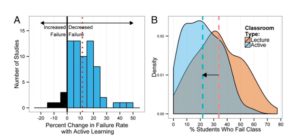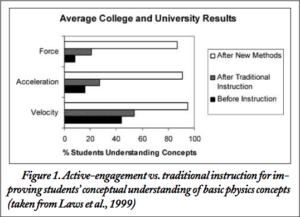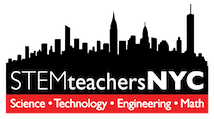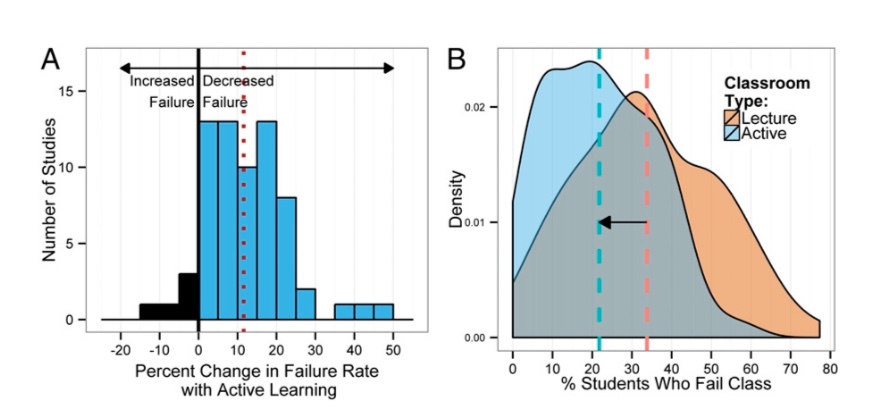Add depth to authentic inquiry and make an impact with active learning in your classroom.
This Summer master teachers Zhanna Glazenburg and Craig Buszka will take a deep dive into Active Learning – but what exactly is Active Learning and how can it help your students?
The largest study of Active Learning to date, a 2014 meta-analysis found that:
 “Current evidence suggests that a constructivist “ask, don’t tell” approach may lead to strong increases in student performance. Students performing in the 50th percentile of a class based on traditional lecturing would, under active learning, move to the 68th percentile of that class… and confers disproportionate benefits for STEM students from disadvantaged backgrounds and for female students in male-dominated fields.
“Current evidence suggests that a constructivist “ask, don’t tell” approach may lead to strong increases in student performance. Students performing in the 50th percentile of a class based on traditional lecturing would, under active learning, move to the 68th percentile of that class… and confers disproportionate benefits for STEM students from disadvantaged backgrounds and for female students in male-dominated fields.
“Often presented or perceived as a radical change from traditional instruction, the topic frequently polarizes faculty… but Hake (1998) examined pre- and post-test data for over 6,000 students in introductory physics courses and found significantly improved performance for students in classes with substantial use of interactive-engagement methods.”
 So what is Active Learning?
So what is Active Learning?
Building on principles and strategies of constructivism, authenticity, and inquiry, Active Learning folds in layers of student agency and ownership, often handing over the reigns of pieces of instructional design to the students, and incorporating meta-cognition of the learning process. Active Learning includes strategies for intentional integration of student perspectives, goals and reflections on their own learning.
From Cathy Davidson at Inside Higher Ed, “Active Learning is a theory and method of teaching that engages students in the process of thinking meaningfully and deliberately about and then co-creating their learning experiences, in the classroom and beyond.” Students might design some or all of their syllabus, influence standards or their own assessment, or even publish their work in a journal or website or teach what they have learned to other students. From the Center for Teaching Innovation at Cornell University “Active learning methods ask students to fully participate in their learning by thinking, discussing, investigating, and creating.”
Active Learning can help students fully step into the real-life methods and practices of STEM fields, but in some cases we may need to create added supports as they change their thinking about how they learn, and their ideas about who can be responsible for that learning. “When we ask our students to adapt to a more complex, self-directed, self-regulated approach, we are often going against their very beliefs about how people learn. Reduce risk-aversion by:
- Assessing the process of learning more than the product.
- Use a rubric that values problem-solving, planning, and resilience during most activities, especially at first. I use this rubric to measure and to provide feedback on the process of learning.
- Create a safe environment where failure is just another opportunity to try again and improve.”
From Davidson again, this time on both the impact of and the underlying democratic nature of Active Learning classrooms: “Engaged learning methods work. We’ve known at least since Ebbinghaus’s memory experiments of the 1880s that students (like all of us) forget up to 75% of the tested or “testable” content learned in a course within six days after taking a summative, high-stakes exam in a course. Active learning — peer-to-peer explanation, exchange, and individual research on the topic — increase retention, understanding, and applicability well beyond the test. You don’t need any technology to transform your classroom from a credential-centered environment to a student-centered, interactive, engaged, research-based, goal driven, egalitarian classroom.”
Join us this summer for a one-week Introduction to Active Learning workshop! Participants will be introduced to the principles of active learning in STEM, strategies such as facilitating student discourse, modeling, multiple representations in problem solving, and curriculum design. We will explore these ideas by investigating content from several cross-cutting-concepts within the physical and life science contexts at middle and high school levels… and you’ll be able to experiment with these teaching tools right away!

